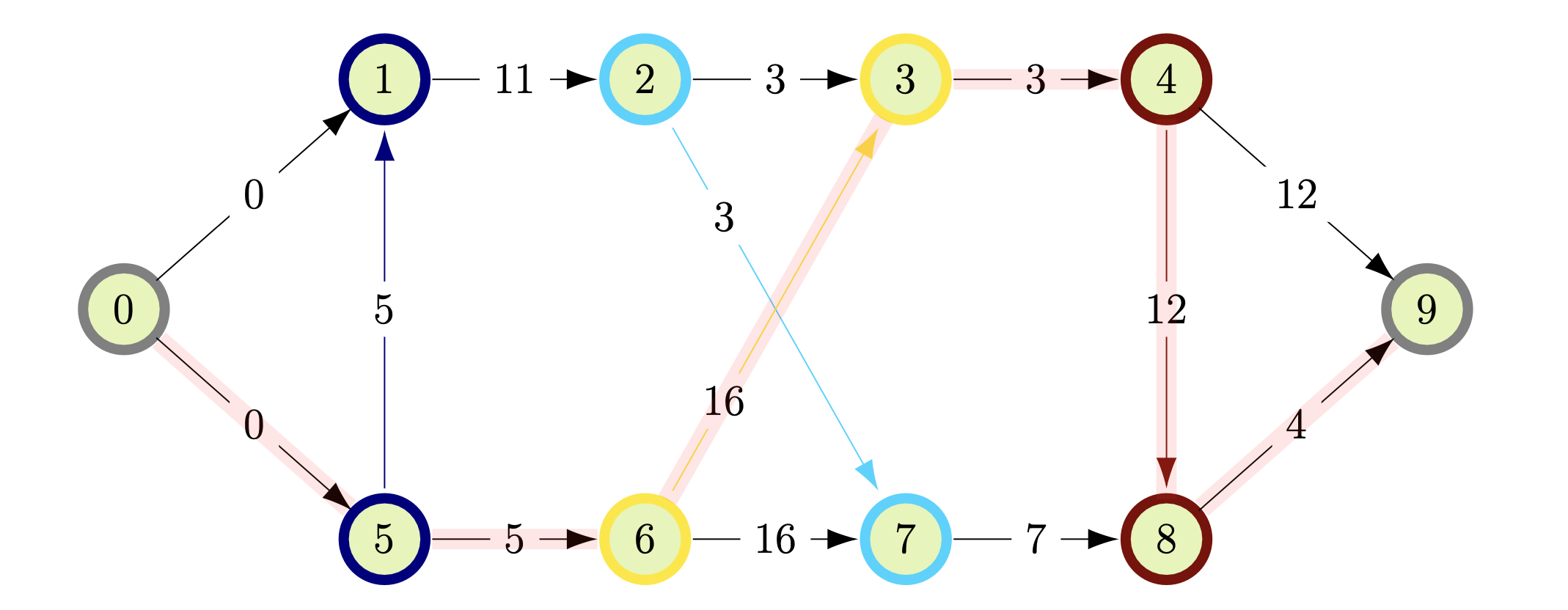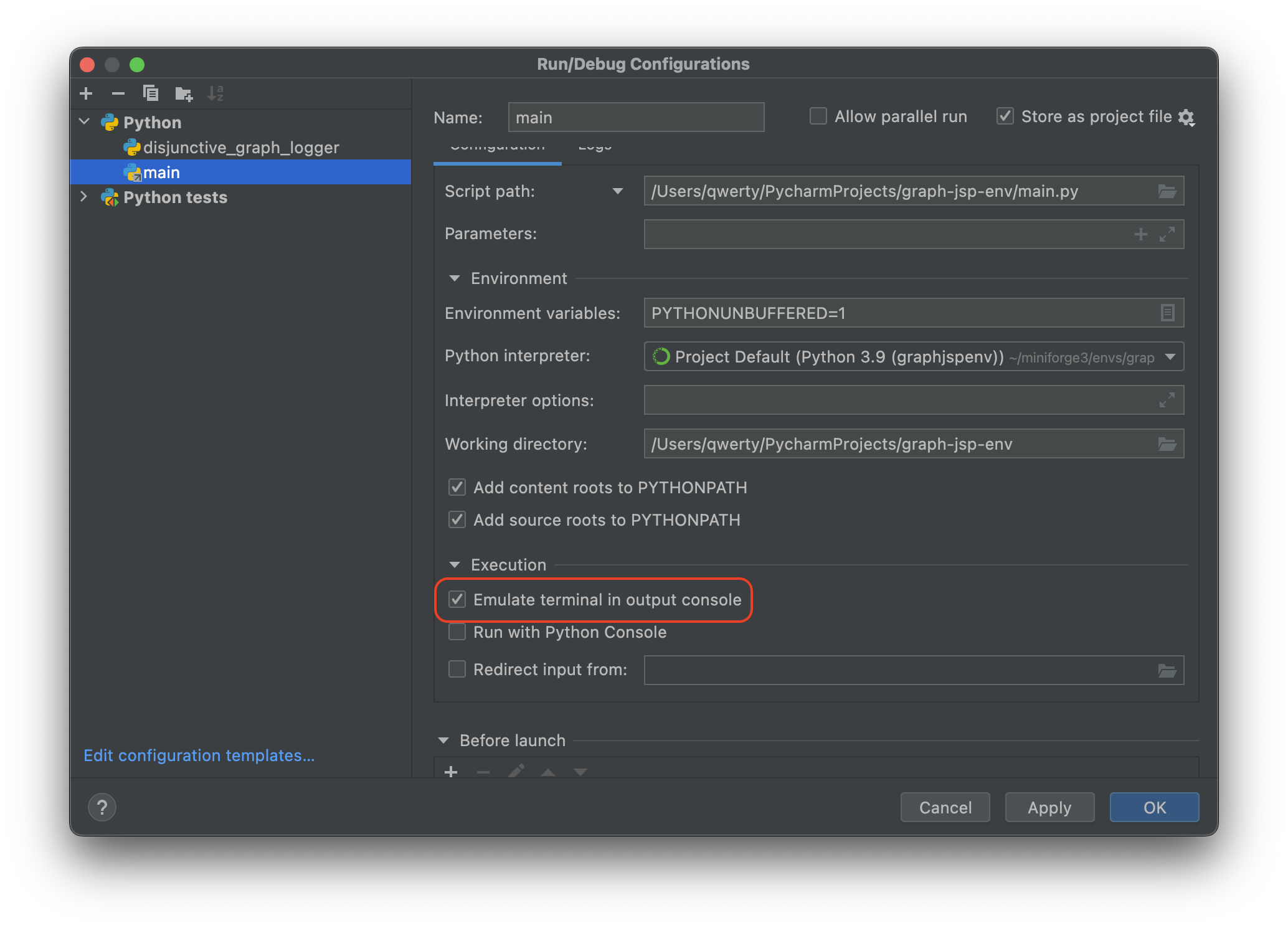A flexible enviorment for job shop scheduling using the disjunctive graph apporach.
Project description
About The Project
An Gymnasium Environment implementation of the Job Shop Scheduling Problem (JSP) using the disjunctive graph approach.
This environment is inspired by the The disjunctive graph machine representation of the job shop scheduling problem by Jacek Błażewicz and Learning to Dispatch for Job Shop Scheduling via Deep Reinforcement Learning by Zhang, Cong, et al.
This environment does not explicitly include disjunctive edges, like specified by Jacek Błażewicz, only conjunctive edges. Additional information is saved in the edges and nodes, such that one could construct the disjunctive edges, so the is no loss in information.
This environment is more similar to the Zhang, Cong, et al. implementation. Zhang, Cong, et al. seems to store exclusively time-information exclusively inside nodes (see Figure 2: Example of state transition) and no additional information inside the edges (like weights in the representation of Jacek Błażewicz).
The DisjunctiveGraphJssEnv uses the networkx library for graph structure and graph visualization.
It is highly configurable and offers various rendering options.
Quick Start
Install the package with pip:
pip install graph-jsp-env
Minimal Working Example: Random Actions
The code below shows a minimal working example without any reinforcement learning
import numpy as np
from graph_jsp_env.disjunctive_graph_jsp_env import DisjunctiveGraphJspEnv
jsp = np.array([
[[1, 2, 0], # job 0
[0, 2, 1]], # job 1
[[17, 12, 19], # task durations of job 0
[8, 6, 2]] # task durations of job 1
])
env = DisjunctiveGraphJspEnv(
jps_instance=jsp,
perform_left_shift_if_possible=True,
normalize_observation_space=True, # see documentation of DisjunctiveGraphJspEnv::get_state for more information
flat_observation_space=True, # see documentation of DisjunctiveGraphJspEnv::get_state for more information
action_mode='task', # alternative 'job'
dtype='float32' # dtype of the observation space
)
terminated = False
info = {}
for i in range(6):
# get valid action mask. sample expects it to be a numpy array of type int8
mask = np.array(env.valid_action_mask()).astype(np.int8)
action = env.action_space.sample(mask=mask)
state, reward, terminated, truncated, info = env.step(action)
# chose the visualisation you want to see using the show parameter
# console rendering
env.render(show=["gantt_console", "graph_console"])
print(f"makespan: {info['makespan']}")
Stable Baselines3
To run the example below you need to install the following packages:
pip install stable_baselines3
pip install sb3_contrib
It is recommended to use the MaskablePPO algorithm from the sb3_contrib package.
import gymnasium as gym
import sb3_contrib
import numpy as np
import stable_baselines3 as sb3
from graph_jsp_env.disjunctive_graph_jsp_env import DisjunctiveGraphJspEnv
from graph_jsp_env.disjunctive_graph_logger import log
from sb3_contrib.common.wrappers import ActionMasker
from sb3_contrib.common.maskable.policies import MaskableActorCriticPolicy
jsp = np.array([
[[1, 2, 0], # job 0
[0, 2, 1]], # job 1
[[17, 12, 19], # task durations of job 0
[8, 6, 2]] # task durations of job 1
])
env = DisjunctiveGraphJspEnv(
jps_instance=jsp,
perform_left_shift_if_possible=True,
normalize_observation_space=True,
flat_observation_space=True,
action_mode='task', # alternative 'job'
)
env = sb3.common.monitor.Monitor(env)
def mask_fn(env: gym.Env) -> np.ndarray:
return env.valid_action_mask()
env = ActionMasker(env, mask_fn)
model = sb3_contrib.MaskablePPO(MaskableActorCriticPolicy, env, verbose=1)
# Train the agent
log.info("training the model")
model.learn(total_timesteps=10_000)
Visualisations
The environment offers multiple visualisation options. There are four visualisations that can be mixed and matched:
gantt_window: a gantt chart visualisation in a separate windowgraph_window: a graph visualisation in a separate window. This visualisation is computationally expensive.gantt_console: a gantt chart visualisation in the consolegraph_console: a graph visualisation in the console
The desired visualisation can be defaulted in the constructor of the environment with the argument default_visualisations.
To enable all visualisation specify default_visualisations=["gantt_window", "gantt_console", "graph_window", "graph_console"].
The default visualisations are the used by the render() method if no visualisations are specified (using the show argument).
Visualisation in OpenCV Window
This visualisation can enabled by setting render_mode='window' or setting the argument default_visualisations=["gantt_window", "graph_window"] in the constructor of the environment.
Additional parameters for OpencCV will be passed to the cv2.imshow() function.
Example:
env.render(wait=1_000) # render window closes automatically after 1 seconds
env.render(wait=None) # render window closes when any button is pressed (when the render window is focused)
Console Visualisation
This visualisation can enabled by setting render_mode='window' or setting the argument default_visualisations=["gantt_console", "graph_console"] in the constructor of the environment.
More Examples
Various examples can be found in the graph-jsp-examples repo.
Development
The following sections are only relevant if you plan on further develop the environment and introduce code changes into the environment itself.
To run this Project locally on your machine follow the following steps:
- Clone the repo
git clone https://github.com/Alexander-Nasuta/graph-jsp-env.git
- Install the python requirements_dev packages.
requirements_dev.txtincludes all the packages of specifiedrequirements.txtand some additional development packages likemypy,pytext,toxetc.pip install -r requirements_dev.txt
- Install the modules of the project locally. For more info have a look at
James Murphy's testing guide
pip install -e .
Testing
For testing make sure that the dev dependencies are installed (requirements_dev.txt) and the models of this
project are set up (i.e. you have run pip install -e .).
Then you should be able to run
mypy src
flake8 src
pytest
or everthing at once using tox.
tox
IDEA
I recommend to use Pycharm. Of course any code editor can be used instead (like VS code or Vim).
This section goes over a few recommended step for setting up the Project properly inside Pycharm.
PyCharm Setup
- Mark the
srcdirectory asSource Root.
right click on the 'src' -> 'Mark directory as' -> `Source Root`
- Mark the
resourcesdirectory asResource Root.
right click on the 'resources' -> 'Mark directory as' -> `Resource Root`
- Mark the
testsdirectory asTest Source Root.
right click on the 'tests' -> 'Mark directory as' -> `Test Source Root`
afterwards your project folder should be colored in the following way:
- (optional) When running a script enable
Emulate terminal in output console
Run (drop down) | Edit Configurations... | Configuration | ☑️ Emulate terminal in output console
License
Distributed under the MIT License. See LICENSE.txt for more information.
Project details
Release history Release notifications | RSS feed
Download files
Download the file for your platform. If you're not sure which to choose, learn more about installing packages.
Source Distribution
Built Distribution
Hashes for graph_jsp_env-0.3.3-py3-none-any.whl
| Algorithm | Hash digest | |
|---|---|---|
| SHA256 | 808f30550d07ba9956cb3985cb3ff7dfd37826a4da34c232c5c3d813173e4eb0 |
|
| MD5 | e1ee696b6feabb77df6dce171791d3fd |
|
| BLAKE2b-256 | f7347420ee431c79d81211eabe04216d1346004b4ca76028feac0485818026c5 |

















